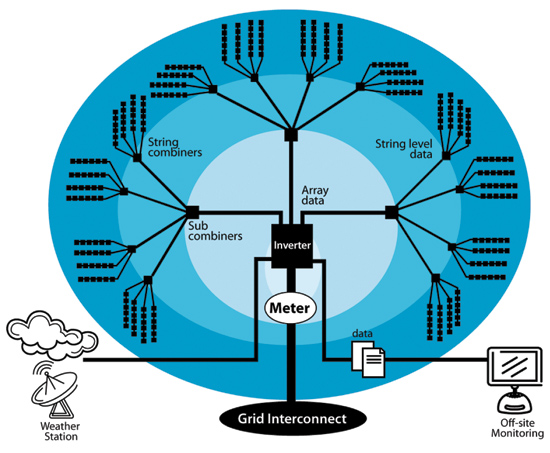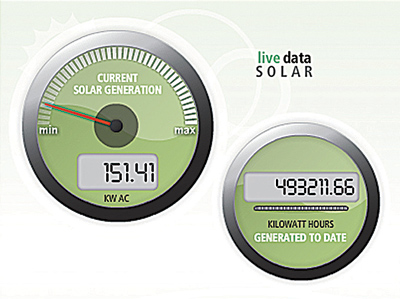Rooftops across Ontario are being transformed. An aerial view of the province reveals that solar panels cover the flat rooftops of hundreds of commercial and industrial buildings. With more than 400 rooftop installations and counting, OZZ Solar ranks as one of the largest solar developers in Canada. The company’s aggressive growth resulted from Ontario Power Authority’s feed-in-tariff (FIT) program. In order for the company, its partners and its customers to fully realize the benefits of the FIT program however, an effective solar monitoring system would prove critical.
FIT Programs Ignite Solar Industry
Enterprises across Canada are putting solar installations on their buildings’ rooftops to reap the benefits of the Ontario Power Authority’s FIT program. Feed-in tariffs offer cost-based compensation to renewable energy producers, ensuring price certainty and long-term contracts with the government. This helps finance renewable energy investments. Germany and Spain rank at the forefront of the solar energy industry, resulting primarily from these countries’ FIT programs.
Solar energy producers receive higher compensation than producers of electricity generated from coal or natural gas, because solar technology is more costly, and this raises generation costs. These building owners can generate power for their own operations, and sell the excess power back into the grid for generous compensation. Solar owners participating in FIT also receive guaranteed grid access. In order for a rooftop solar installation to qualify for Ontario’s FIT program, the installation must be located on an existing, permanent building intended for a primary purpose other than supporting a solar installation.
Solar System Monitoring is Key to Reaping FIT Rewards
FIT programs tie their payment levels to the performance of the solar installation, placing the incentive with producers to maximize the overall output and efficiency of their project. The more power a solar installation generates, the higher the compensation amount. Solar installation owners, therefore, reap the maximum benefit from their investment through solar system monitoring to ensure maximum performance.
Solar requires granular monitoring of installations down to the string level to verify that the solar systems generate as much power as technologically possible. OZZ Solar named Capgemini as a solution provider for a planned test of a granular monitoring solution at its 130-kilowatt-hour solar installation on the corporate headquarters rooftop. If the test was successful, granular monitoring solutions would be implemented at all of its installations.
Monitoring at the Meter on the AC Side is Not Enough
A multi-tiered monitoring approach that provides diagnostic information on all aspects of rooftop solar systems was selected based on Capgemini recommendations. And although other companies in the industry offer solutions that monitor at the revenue-grade meter on the AC side, this limited monitoring does not pinpoint individual solar panel malfunctions. To also provide string-level granular monitoring on the system’s DC side, Capgemini teamed up with DECK Monitoring, a maker of monitoring software.
“If a solar panel goes down, it tends to bring down the whole string,” said Will Shortt, Deck Monitoring CEO. “In a large, multi-panel project, you wouldn’t know if one panel was down from monitoring the whole system, either from the inverter or the meter. We provide broad monitoring information but then also drill down to the string level.”
How String-Level Granular Monitoring Works
Capgemini built a control center to provide on-site monitoring at the headquarters facility. The control center’s monitoring team compares the output of strings within the same solar system. The team uses this data to identify wiring, shading, or other minor maintenance issues that would otherwise escape detection. (Figure 1)

Figure 1. System performance is monitored at the string level, and this data is used to identify
wiring, shading, or other minor maintenance is-sues that might otherwise escape detection.
To track the rate of hardware degradation, the monitoring team also compares the strings’ output over time. This can minimize system efficiency losses and downtime due to unnoticed decreases in performance or unanticipated failures. The monitoring system tracks the performance of the specific solar system compared to other existing solar systems so that future installation designs can be built on lessons learned from the comparative study.
The monitoring solution employs a data-intensive back-end administrative panel that monitors the performance of each portion of the system. As part of the administrative panel, the billing and reporting center tabulates production data over variable time periods, the projected electricity purchase price, and a revenue percentage to produce roof rent estimates for income reconciliation purposes.
The data acquisition software, called the “gateway,” communicates with supplied meters and data-gathering hardware that connects via Modbus or Pulse data protocols, or wireless signals. The included CT meter measures system generation after the inverter on the AC side. The gateway stores the data for 90 days using flash memory in the event that Internet service fails. The monitoring system pushes the data to the servers every 15 minutes, automatically updating the data in the dashboard and administrative panel. In addition, a third-party hosting and backup company stores data off site.
The solution’s hardware components allow for expandability, provide high-resolution data, and have low failure rates. Demand monitoring capabilities, integration with other building energy management systems, and another solar array or weather station can be added at any time.
The solution can also be integrated into the local utilities outage management system or distribution management system and provide real-time connectivity and control as part of an integrated smart grid solution.
Monitoring Delivers Valuable Data
As soon as the system was set up and the communication link was established, Capgemini began remotely monitoring the installation, comparing the power output of each string against other strings. The monitoring team cross references pre-installation energy production forecasts and actual performance data against site-specific weather data to predict power output, identify variations from the prediction, and identify system failures requiring on-site intervention to maximize power output. (Figure 2)

Figure 2. Solar equipment is remotely monitored to track how much power is generated in real time and to date.
Solar is Hot in Ontario
When system alarms sound indicating possible equipment malfunctions, control center analysts determine if a repair crew should in fact be dispatched. For example, a sunny but snowy morning in winter may not result in power generation if solar panels must heat up after the snow slides off. The lack of power generation does not indicate faulty equipment, however, so the operations center does not need to dispatch a repair crew. Once control center analysts determine the need for on-site troubleshooting, a trouble ticket is issued and a request for a local operations and maintenance team is issued to dispatch a qualified crew.
Whenever possible, the control center analysts identify the failed or underperforming strings and their relative geography on the array to decrease repair time. The system also tracks historical system and maintenance issues. The maintenance process is also monitored to ensure that repairs under warranty are covered as well as tracking and recording work tickets.
Solution Yields Other Benefits
Studies indicate that granular monitoring of solar installations typically increases power production by five percent over the lifetime of the system. Optimal power production will enable users to receive the maximum return on their investments in solar installations. With long-term guaranteed government contracts, maximum productivity translates into maximum financial return. It can also can play an important role in customer public relations strategy since it includes user-friendly dashboards that tabulate solar system energy production and the energy savings derived from solar generation. And, the dashboards can be installed on building lobby kiosks, or on company Facebook or web pages to help promote the solar projects to the public.
The system also analyzes greenhouse gas emission reductions resulting from the solar power generation based on standard calculations from the U.S. Department of Energy. Moreover, this information can be communicated to the public to emphasize the company’s commitment to environmental stewardship. Among the many benefits this monitoring approach provides are operations and maintenance efficiency, long-term technology evaluation, and validation of the asset investment.
About the Author

Tom Crawford is Senior Manager and a member of the Capgemini - Global Smart Energy Services team. He has 35 years of utility industry experience with a strong focus in smart grid, utility distribution operations and field operations. Tom’s electrical utility background and leadership in distribution automation, smart meter and smart grid initiatives have provided him with the expertise in advising utility clients, worldwide on business and technology solutions including utility business process design and change management, distribution automation, outage management and customer communications, utility emergency management, PHEV, EV and EV Infrastructure, solar technology, work force automation and mobile IT.







